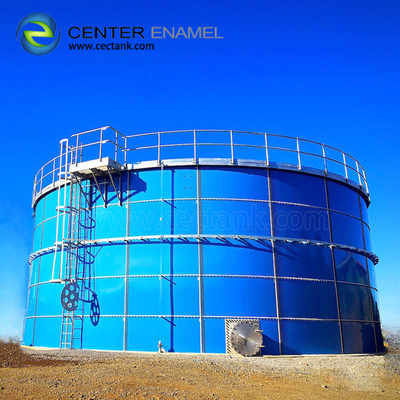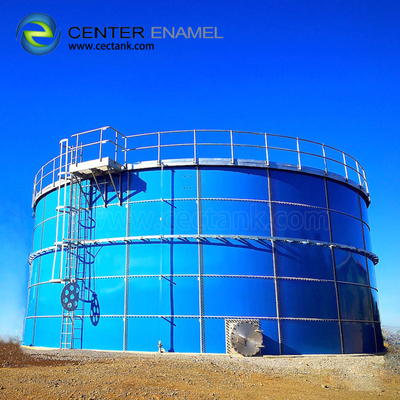-
Glass Fused To Steel Tanks (419)
-
Stainless Steel Tanks (410)
-
Fusion Bonded Epoxy Tanks (424)
-
Galvanized Steel Tanks (321)
-
Aluminum Dome Roofs (872)
-
Wastewater Storage Tanks (226)
-
Welded Steel Tanks (297)
-
Pressure Vessels (295)
-
Anaerobic Digester (201)
-
Industrial Water Tanks (349)
-
Glass Lined Steel Tanks (180)
-
Bolted Steel Tanks (181)
-
Sludge Storage Tank (115)
-
Biogas Storage Tank (173)
-
Leachate Storage Tanks (133)
-
Agricultural Water Storage Tanks (179)
-
Fire Water Tank (166)
-
Grain Storage Silos (130)
-
Biogas Projects (349)
-
Wastewater Treatment Projects (270)
-
Double Membrane Roof (223)
Biogas Storage Tanks: The Vital Reservoir for Sustainable Energy
| Place of Origin: | China |
| Brand Name: | CEC TANKS |
| Certification: | ISO 9001:2008, AWWA D103 , OSHA , BSCI |
| Model Number: | W20171016013 |
| Minimum Order Quantity: | 1set |
| Price: | $5000~$20000 one set |
| Packaging Details: | PE poly-foam between each two steel plates ; wooden pallet and wooden box |
| Delivery Time: | 10-30 days after deposit received |
| Supply Ability: | 60 sets per month |
|
Detail Information |
|||
| Place of Origin | China | Brand Name | CEC TANKS |
|---|---|---|---|
| Certification | ISO 9001:2008, AWWA D103 , OSHA , BSCI | Model Number | W20171016013 |
| Coating Thickness: | 0.25mm~0.40mm & Double Coating | Capacity: | 20 M3 To 18,000 M3 |
| Foundation: | Concrete Or Glass Fused Steel | Size Of Panel: | 2.4M * 1.2M |
| Easy To Clean: | Smooth, Glossy, Inert, Anti-adhesion | Feature: | Eco-friendly, Durability |
| Highlight: | biogas storage tank for sustainable energy,industrial biogas storage reservoir,large capacity biogas storage tank |
||
Product Description
Biogas Storage Tanks: The Vital Reservoir for Sustainable Energy
Biogas plants are at the forefront of renewable energy generation, converting organic waste into a valuable fuel source. Central to their efficient operation is the biogas storage tank, a critical component that bridges the gap between fluctuating gas production and consistent energy demand. These tanks act as the vital reservoir, ensuring a steady supply of biogas for power generation, heating, or upgrading to biomethane.
Why are Biogas Storage Tanks Essential?
The anaerobic digestion process, while efficient, doesn't always produce biogas at a constant rate, and energy consumption often varies throughout the day or week. Biogas storage tanks address these challenges by:
-
Buffering Production Fluctuations: They store excess biogas produced during peak activity, preventing flaring (burning off excess gas) and maximizing energy recovery.
-
Ensuring Consistent Supply: Stored biogas can be drawn upon during periods of lower production or higher demand, ensuring a stable and reliable energy supply.
-
Pressure Regulation: They help maintain optimal gas pressure for downstream equipment, such as combined heat and power (CHP) units, boilers, or biogas upgrading systems.
-
Safety and Environmental Protection: By containing the flammable biogas, they prevent its uncontrolled release into the atmosphere, reducing greenhouse gas emissions and mitigating explosion risks.
-
Odor Control: A well-sealed storage tank effectively contains any odors associated with the biogas or digester contents.
Types of Biogas Storage Tanks: Material Matters
The choice of material and design for biogas storage tanks is crucial, as the stored biogas (a mixture primarily of methane and carbon dioxide, often with corrosive hydrogen sulfide and moisture) can be challenging. Key considerations include corrosion resistance, gas tightness, durability, and cost-effectiveness.
Here are the most common types:
-
Glass-Fused-to-Steel (GFS) Tanks:
-
Construction: These are bolted steel tanks where steel panels are coated with a vitreous enamel (glass) layer at high temperatures, creating a chemical bond.
-
Advantages: Exceptional corrosion resistance to the harsh components of biogas (especially H2S), highly inert, hygienic, very long lifespan (often 30-50+ years), low maintenance, and excellent gas tightness. Their modular design allows for relatively fast on-site assembly.
-
Disadvantages: Higher initial capital cost compared to some alternatives, and the glass lining can be susceptible to impact damage if not handled carefully during installation or operation.
-
-
Double Membrane Gas Holders:
-
Construction: These are flexible, balloon-like structures made from high-strength, gas-tight membranes (typically PVC-coated polyester fabric). They usually consist of an inner membrane that holds the biogas and an outer membrane that provides weather protection and maintains positive pressure with a supporting air blower.
-
Advantages: Highly flexible, accommodating significant volume changes, excellent gas tightness, relatively low capital cost, easy and fast installation, and visually indicate the gas volume. They are also resistant to many corrosive elements in biogas.
-
Disadvantages: Susceptible to physical damage (punctures), have a shorter lifespan than rigid tanks, and can be affected by extreme weather conditions (e.g., strong winds or heavy snow if not properly designed with internal support or air pressure management).
-
-
Fusion Bonded Epoxy (FBE) Coated Steel Tanks:
-
Construction: Similar to GFS tanks in their bolted steel panel construction, but with a thermosetting epoxy powder coating applied and cured at the factory.
-
Advantages: Good corrosion resistance, more flexible and impact-resistant than glass, easier to repair minor damage in the field, and generally more cost-effective than GFS tanks.
-
Disadvantages: Chemical resistance is not as broad as glass, and their long-term performance in very aggressive biogas environments might not match GFS. They also have temperature limitations.
-
-
Stainless Steel Tanks:
-
Construction: Made entirely from stainless steel panels, either bolted or welded.
-
Advantages: Excellent inherent corrosion resistance, high hygiene, and very long lifespan. No coating to worry about.
-
Disadvantages: Highest initial capital cost among the common options, making them less common for large-scale biogas storage unless specific purity requirements or highly corrosive conditions justify the investment.
-
-
Concrete Tanks with Linings:
-
Construction: Traditionally used as digester tanks, concrete tanks can be adapted for biogas storage, often requiring specialized gas-tight linings or covers.
-
Advantages: Strong, durable, and can be built to very large capacities.
-
Disadvantages: Concrete itself is not inherently gas-tight, requiring specialized and often expensive internal coatings or membrane covers. Construction is typically slower and more weather-dependent than bolted steel tanks.
-
Safety and Regulatory Considerations
Given biogas's flammable nature and the presence of toxic components like hydrogen sulfide, safety is paramount in the design, construction, and operation of biogas storage tanks. Key safety measures and regulatory considerations include:
-
Gas Leak Detection: Methane and H2S detectors are essential in and around the tank area.
-
Pressure Relief Valves: Tanks must be equipped with safety valves to prevent over-pressure or vacuum conditions.
-
Flame Arrestors: To prevent flashbacks into the tank.
-
Proper Ventilation: Especially for indoor installations or confined spaces around the tank.
-
Corrosion-Resistant Materials: All piping and equipment in contact with biogas must be designed to withstand its corrosive properties.
-
Emergency Response Plans: Clear procedures for leaks, fires, and other emergencies are vital.
-
Compliance with Standards: Adherence to international and local standards such as AWWA D103 (for bolted steel tanks), API 650 (for welded tanks, often referenced), ISO standards, and relevant national safety regulations is non-negotiable.
The Future of Biogas Storage
As the world increasingly turns to renewable energy, biogas plants will play a crucial role in waste management and sustainable energy production. Biogas storage tanks, particularly advanced bolted steel options like GFS and FBE, along with robust membrane holders, will continue to evolve, offering more efficient, durable, and cost-effective solutions to harness the full potential of this valuable green energy source. The right storage solution is not just a container; it's a strategic investment in the long-term success and safety of any biogas facility.




